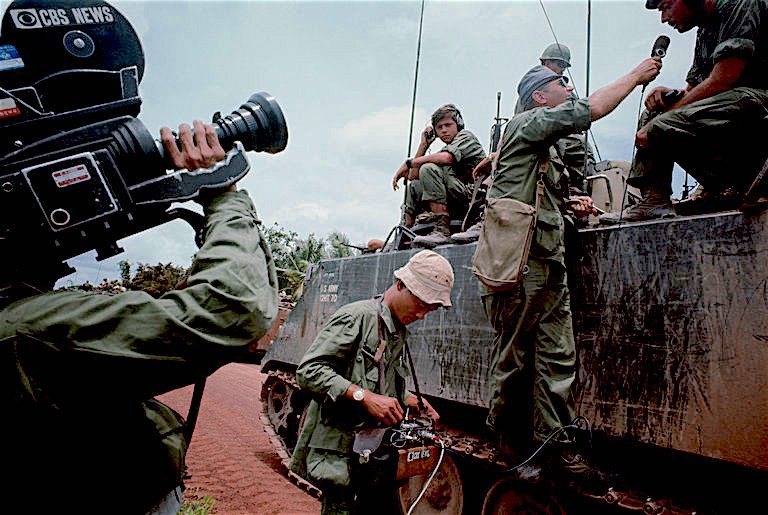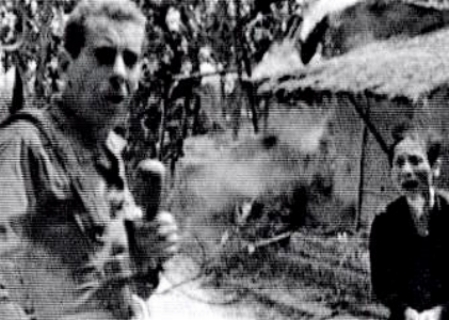Fifty years ago, the United States - plus several of its military allies, including Australia - was embroiled in a war in Indo-China that seemed without end. The conflict in Vietnam - and its exhaustive nightly coverage on television news - came to haunt the American body politic, and America’s first-ever military defeat launched a post-postwar era of political division that has played out to this day. This essay is drawn from a range of sources including my primary research, interviewing former TV war correspondents. Over two decades of conflict, more than 60 reporters were killed.
CBS camera crew interviewing American troops in Vietnam, 1967. (Photo by Tim Page/Corbis)
Two stories.
In 1951, en route to Korea, CBS broadcaster Ed Murrow is confronted at Tokyo Airport by a World War Two media veteran, who runs across the tarmac yelling: “Go back, go back, you silly son of a bitch! This isn’t our kind of war!”
Three years later, the legendary photojournalist Robert Capa steps on a mine in Indo-China and dies clutching his camera. The attending doctor asks, “Is this the first American correspondent killed in Indochina?” When told it is, he replies, “It is a harsh way for America to learn.” The very nature of war had changed, and in Vietnam new lessons would be learned the hard way.
In the early 1960s, in what the Vietnamese would call the ‘American War’, newsreel cameramen and print and radio reporters moved into television news, and, with a dynamic new medium at their disposal and free of the burden of censorship, they began to capture monumental changes in the conduct of war, and in coverage of human suffering.
In 1962, Walter Cronkite started hosting CBS Evening News, the first half-hour nightly bulletin; as concern over the Vietnam War grew, he would ultimately plunge the sword of television into the heart of the American presidency. But for now, the relentless eye of the TV news camera gave viewers compelling evidence not only of U.S. successes but also failures, and left officials floundering.
Barry Zorthian, head of U.S. public affairs in Saigon, the original master of ‘spin’, countered by feeding television crews with upbeat film clips. Some took his tainted offerings, an easier option than flying into conflict zones and being shot at. But most TV correspondents opted to learn their new craft through the classroom of war.
A young Dan Rather, CBS News, honing his field reporting skills.
Rising broadcast talents like Peter Jennings, Morley Safer and Dan Rather risked their lives to get footage of American troops in action against Communist forces. The equipment was bulky, but what it produced could be gripping, even spectacular - edge-of-seat accounts of young men, many still teenagers, under fire from a skilled and unforgiving enemy.
For these pioneers, a critical factor was the difficulty of contact between network headquarters in New York and London and the bureaus in Saigon - in a world without satellites, mobile phones or email, correspondents could easily ignore directions from above and chase more newsworthy stories on their own initiative. This ‘renegade’ factor - the inverse of today’s homogenized, heavily-directed coverage - produced some of the most critically acclaimed stories, and set the standard for war coverage to come.
Television reporters began peeling back the heroic façade of war, showing to home viewers - for the first time - not a ‘gallant venture’ but a game of dice in which there were really no winners. Nightly news stories from Vietnam became grittier, darker, and more challenging of the official version of events. Soon there were rumblings, not only from the new president in Washington, Lyndon Johnson, who loathed and distrusted TV as a news medium, but from inside the television industry as well - a foretaste of bitter struggles to come. The controversial realm of televised warfare was under way.
Barely six months after U.S. troops land at Da Nang in 1965, CBS’s Morley Safer, with a single location report, would negatively reshape impressions of the Vietnam War around the world - and bring to the surface tensions between TV correspondents in the field, their New York masters, and the White House.
CBS’s Morley Safer reporting from the burning village of Cam Ne.
On August 5, Safer accompanied U.S. Marines whose mission, he was told, was to “punish a village”. After several Marines were wounded, most likely by friendly fire, soldiers shot into the village of Cam Ne, and, facing no resistance, held their Zippo lighters to thatched roofs and proceeded to ‘waste’ the hamlet. Safer’s report was unflinching:
This is what the war in Vietnam is all about. The old and the very young. The Marines have burned this old couple’s cottage because fire was coming from here. A hundred and fifty homes were leveled in retaliation for a burst of gunfire. In Vietnam, like everywhere else in Asia, property, a home, is everything. […] If there were Viet Cong in the hamlet, they were long gone. The women and the old men who remained will never forget this August afternoon.
After fierce debate at CBS headquarters in New York, Safer’s “incendiary” report was screened two nights later, igniting, in Safer’s own words, “a powder keg of suspicion, even hatred”. The next morning CBS president Frank Stanton was phoned by a fuming President Johnson, accusing the network of a “lack of patriotism”. Safer recounted:
The president said, “Frank?” “Yeah, who is this?” He said, “This is your president.” “Yes, Mr. President?” “Frank, you trying to fuck me? You know what you did to me last night?” “What did I do, sir?” “You shat on the American flag.”
Safer’s report had infuriated the Commander-in-Chief, disturbed loyal CBS viewers and challenged the Pentagon. “I spent a decade reporting from Vietnam to become a pariah within the U.S. military establishment,” observed Peter Arnett. “Morley Safer achieved similar status in just one afternoon.”
TV coverage of the Vietnam War ultimately defeated Lyndon Baines Johnson.
A new rigor had been set. Television would henceforth be an independent critic, rather than a subservient tool, of the military, of the White House, and of the war itself. That in turn would make the job of reporting Vietnam for television a whole lot harder.
As the war effort soured and morale slumped, so did relations between TV war correspondents and American troops. Where previously the media had been welcome, television crews were now ‘the enemy’. Said one soldier assigned to look after a CBS outfit, “They would come by helicopter or truck, stay a few hours, then go back to places with drinks and clean sheets, leaving us to our misery. They did not carry weapons and did not fight and therefore could not defend you.” TV correspondents and cameramen were seen as parasites, but they kept on reporting and filming.
Across America, anti-war taunts grew strident: “Hey, LBJ, how many kids did you kill today?” U.S. networks were each spending more than $US1 million annually on covering the war, showing the American forces in action. Television itself had created an insatiable appetite for battle images. One correspondent noted New York producers wanted “bang-bang stuff”, not complexities. “They wanted bodies. Air strikes. They wanted napalm going off.” Increasingly, the conflict was also between network correspondents and their employers.
Meanwhile, Communist forces were planning a masterstroke that would elevate dramatically the role of television reporting. On the night of 30 January 1968, launching the Tet Offensive, Viet Cong and North Vietnamese troops attacked targets in fourteen major centers across the country. The impact as shown on nightly television news was devastating.
When Walter Cronkite told Americans there was no way the war could now be justified, “The president flipped off the set and said, ‘If I’ve lost Cronkite, I’ve lost middle America.’” Bankrupted politically, bereft personally, LBJ announced he would not contest the elections later that year. Television had not lost the war, but it had destroyed his presidency.
General Nguyen Ngoc Loan shooting a Viet Cong suspect, Saigon, 1968.
In this crucial phase of the war, three media events had phenomenal effect. During Tet, Vietnamese cameraman Vo Suu, working for NBC, filmed a Viet Cong suspect being shot in cold blood by Saigon’s police chief General Nguyen Ngoc Loan. Later, the indelible image of Vietnamese girl Kim Phuc - running naked from a napalm attack - haunted viewers worldwide, and stifled America’s mission in Vietnam. Her plight, filmed by NBC’s Le Phuc Dinh, offered a searing metaphor for the war’s insanity.
Conversely, in 1968, the My Lai massacre, in which Vietnamese peasants were raped, mutilated, and had their throats slit by U.S. Marines, was not television news’ finest hour. It reacted far too slowly to this horror, a chilling indication of how inured America - and the TV medium - was becoming to the violence being perpetrated.
By 1970, thousands of American troops were refusing to follow orders. CBS filmed disillusioned GIs smoking marijuana from a rifle barrel. The war had started taking its toll: by 1975, more than sixty correspondents would be killed in action, many from television networks. But to its bitter end, the Vietnam War remained a magnet for TV journalists.
In March 1975, amid big Communist advances, South Vietnamese troops retreated; many units were disbanding and refusing to fight. On the morning of 29 April, 1975, CIA operatives in Saigon instigated the evacuation plan, ‘Frequent Wind’. Panic set in as Westerners fled the capital. One stayed put, to capture on film the ‘decisive moment’ of America’s stupendous defeat.
Arriving in Vietnam from Australia in 1964, Neil Davis was already a top-flight news cameraman, albeit with a penchant for brown suede boots and “trousers in varying pastel shades”. Quickly the handsome Davis acquired a dual reputation - as a fearless operator, filming war “at the extreme front line” for the international agency Visnews, and as a man of the night: drinker and gambler, relentless lady killer, opium smoker.
Australian cameraman Neil David aboard a chopper in Vietnam.
Now, after eleven years of war and countless injuries, once nearly losing a leg, Davis faced the greatest challenge - and danger - of his career. As hysterical Vietnamese begged to be choppered out, Davis went to Saigon’s Presidential Palace and found the President of South Vietnam, General ‘Big’ Minh, unshaven. “The other side will be here shortly,” said Minh, eyes red with tears. Davis went downstairs with his camera, and waited.
The end, caught on camera: the final moments of the war, 1975.
Just after midday, North Vietnamese tank 843 rumbled from a side street, fired, and tracked towards the palace’s massive iron gates. Davis started filming. The T-54 tank crushed through the gates and kept coming, and Davis kept filming. A Communist fighter leapt from the tank, angrily pointed his rifle at Davis and warned, “Stop! Hands up.” But filming “the greatest scoop one could imagine”, he kept rolling and waited for the bullet.
“Stop! Are you American?”
Davis finally lowered his hefty Auricon camera. “No, I’m an Australian.” The soldier was baffled. Then Davis said in perfect Vietnamese, “Welcome to Saigon, comrade. I’ve been waiting for you.”
With these words, the Vietnam War was over.







